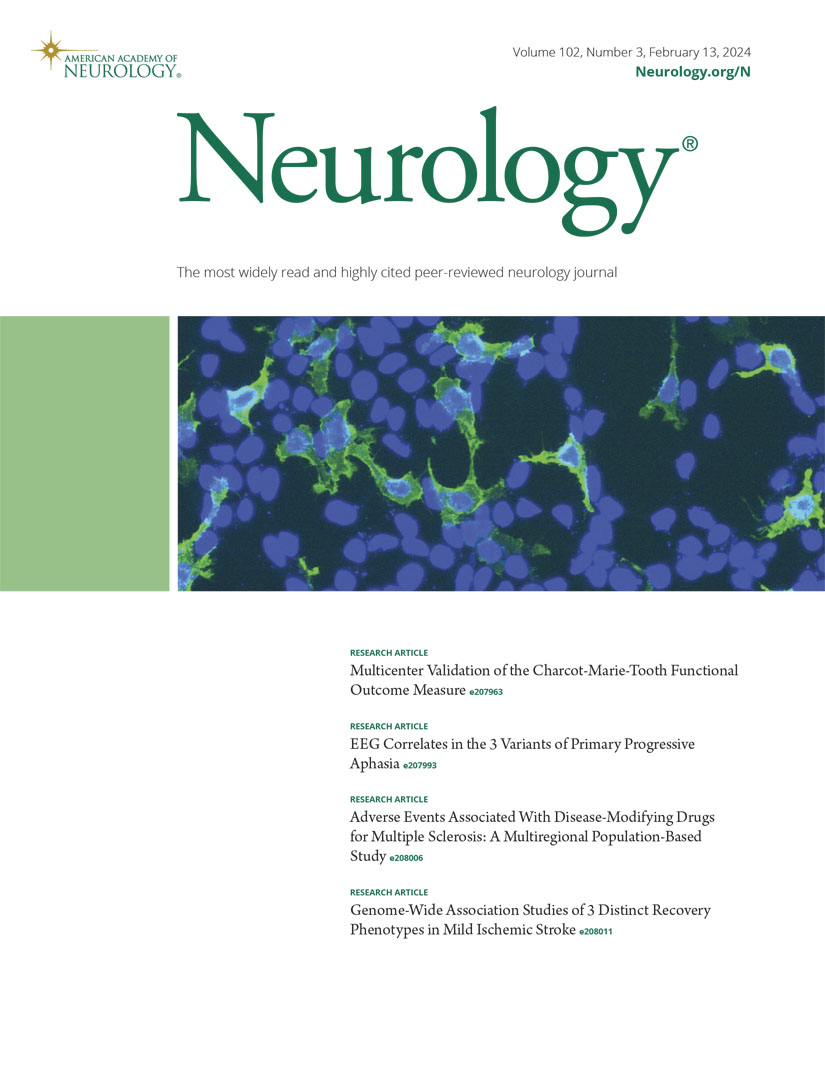社区动脉粥样硬化风险中阿尔茨海默病和神经变性的嗅觉和血浆生物标志物研究
IF 7.7
1区 医学
Q1 CLINICAL NEUROLOGY
引用次数: 0
摘要
背景与目的研究嗅觉障碍(阿尔茨海默病(AD)的早期表现)与AD血浆生物标志物和神经退行性变的关系,可以为阿尔茨海默病的病理生理学提供新的见解。由于基于大型、多样化、以社区为基础的人群的研究很少,我们调查了社区居住的黑人和白人老年人的气味识别能力与AD和其他神经退行性病理的血浆生物标志物的关系。方法:本横断研究纳入了社区动脉粥样硬化风险研究的参与者,他们参加了第5次访问(2011-2013),完成了嗅觉测试和脑MRI检查,并测量了血浆生物标志物(即淀粉样蛋白- β [Aβ]42/Aβ40比值,苏氨酸-181磷酸化tau [p-tau181], p-tau181/Aβ42比值,胶质纤维酸性蛋白[GFAP]和神经丝轻链[NfL])。气味识别能力采用12项嗅探棒测试。使用单独的线性回归模型来检验连续嗅觉评分与嗅觉类别(嗅觉缺失:得分6;嗅觉减退:7 - 8;moderate-normal: 9;良好-正常:11-12),每个生物标志物(均进行对数转换),调整社会人口统计学和心血管因素,头部损伤,APOE-ε4状态和估计肾小球滤过率。我们进一步研究了是否有任何观察到的关联可以用总脑容量和局部脑容量来解释。结果1545名参与者(年龄:76±5岁,60%为女性,27%为黑人自我报告参与者),平均嗅觉评分为9.2±2.3;14%有嗅觉缺失。与我们的假设一致,较差的嗅觉评分与较高的血浆p-tau181(每1单位低评分:0.026 [95% CI 0.012-0.040])、p-tau181/ a - β42 (β: 0.027 [95% CI 0.011- 0.044])、GFAP (β: 0.024 [95% CI 0.009-0.040])和NfL (β: 0.034 [95% CI 0.019-0.050]和较低的a - β42/ a - β40比值(β: -0.007 [95% CI -0.015至0.000])相关。同样,与良好的正常嗅觉相比,嗅觉缺失与所有生物标志物水平相关,表明神经病理更严重(例如,血浆p-tau181/ a - β42的β: 0.235 [95% CI 0.113-0.358],血浆NfL的β: 0.210 [95% CI 0.102-0.317]),尽管与a - β42/ a - β40的相关性无统计学意义(β: -0.054 [95% CI -0.108 - 0.001])。这些生物标志物与低氧或中度正常嗅觉没有显著相关性。较小的内侧颞叶体积部分解释了嗅觉与血浆p-tau181、p-tau181/ a - β42、GFAP和NfL之间的联系。我们的研究结果表明嗅觉差与多种ad相关和其他神经退行性过程有关。未来的研究应该调查嗅觉和生物标志物的纵向变化是如何相互关联的。本文章由计算机程序翻译,如有差异,请以英文原文为准。
Olfaction and Plasma Biomarkers of Alzheimer Disease and Neurodegeneration in the Atherosclerosis Risk in Communities Study.
BACKGROUND AND OBJECTIVES
Investigation of olfactory impairment, an early manifestation of Alzheimer disease (AD), in relation to plasma biomarkers of AD and neurodegeneration could provide insights into the disease's pathophysiology. Because few such studies based on large, diverse, community-based populations exist, we investigated associations of odor identification ability with plasma biomarkers of AD and other neurodegenerative pathologies in community-dwelling Black and White older adults.
METHODS
This cross-sectional investigation included participants from the Atherosclerosis Risk in Communities study who attended visit 5 (2011-2013) and who completed olfactory testing and brain MRI examinations and had plasma biomarkers measured (namely, amyloid-beta [Aβ]42/Aβ40 ratio, phosphorylated-tau at threonine-181 [p-tau181], p-tau181/Aβ42 ratio, glial fibrillary acidic protein [GFAP], and neurofilament light chain [NfL]). Odor identification ability was measured by the 12-item Sniffin' Sticks test. Separate linear regression models were used to examine the association of continuous olfaction score and olfaction categories (anosmia: score 6; hyposmia: 7-8; moderate-normal: 9-10; good-normal: 11-12) with each biomarker (all were log-transformed), adjusting for sociodemographic and cardiovascular factors, head injury, APOE-ε4 status, and estimated glomerular filtration rate. We further examined whether any observed associations are explained by total and regional brain volumes.
RESULTS
Among 1,545 participants (age: 76 ± 5 years, 60% women, 27% self-reported Black participants), the mean olfaction score was 9.2 ± 2.3; 14% had anosmia. Consistent with our hypotheses, poorer olfactory scores were associated with higher plasma p-tau181 (β per 1-unit lower score: 0.026 [95% CI 0.012-0.040]), p-tau181/Aβ42 (β: 0.027 [95% CI 0.011- 0.044]), GFAP (β: 0.024 [95% CI 0.009-0.040]), and NfL (β: 0.034 [95% CI 0.019-0.050] and lower Aβ42/Aβ40 ratio (β: -0.007 [95% CI -0.015 to 0.000]). Likewise, compared with good-normal olfaction, anosmia showed associations with all biomarker levels indicative of greater neuropathology (e.g., β for plasma p-tau181/Aβ42: 0.235 [95% CI 0.113-0.358] and β for plasma NfL: 0.210 [95% CI 0.102-0.317]), although the association with Aβ42/Aβ40 ratio was not statistically significant (β: -0.054 [95% CI -0.108 to 0.001]). These biomarkers were not significantly associated with hyposmia or moderate-normal olfaction. Smaller medial-temporal lobe volumes partly explained olfaction's link with plasma p-tau181, p-tau181/Aβ42, GFAP, and NfL.
DISCUSSION
Our findings suggest that poor olfaction is associated with multiple AD-related and other neurodegenerative processes. Future studies should investigate how longitudinal changes in both olfaction and biomarkers relate to each other.
求助全文
通过发布文献求助,成功后即可免费获取论文全文。
去求助
来源期刊

Neurology
医学-临床神经学
CiteScore
12.20
自引率
4.00%
发文量
1973
审稿时长
2-3 weeks
期刊介绍:
Neurology, the official journal of the American Academy of Neurology, aspires to be the premier peer-reviewed journal for clinical neurology research. Its mission is to publish exceptional peer-reviewed original research articles, editorials, and reviews to improve patient care, education, clinical research, and professionalism in neurology.
As the leading clinical neurology journal worldwide, Neurology targets physicians specializing in nervous system diseases and conditions. It aims to advance the field by presenting new basic and clinical research that influences neurological practice. The journal is a leading source of cutting-edge, peer-reviewed information for the neurology community worldwide. Editorial content includes Research, Clinical/Scientific Notes, Views, Historical Neurology, NeuroImages, Humanities, Letters, and position papers from the American Academy of Neurology. The online version is considered the definitive version, encompassing all available content.
Neurology is indexed in prestigious databases such as MEDLINE/PubMed, Embase, Scopus, Biological Abstracts®, PsycINFO®, Current Contents®, Web of Science®, CrossRef, and Google Scholar.
 求助内容:
求助内容: 应助结果提醒方式:
应助结果提醒方式:


